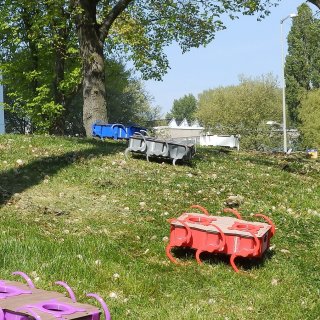Mattijs Otten, an Industrial Design Engineering student at Delft University of Techology, has created a modular design that facilitates serial production of the Zebro. Zebros are walking hexapod robots. In the future, researchers plan to create autonomous ‘swarms’ of these robots, and serial production is essential to achieving this goal.
Zebros are a bit like insects, but the friendliest types you could imagine. Carried on sturdy legs and armed with audio sensors, Zebros are able to explore difficult and dangerous terrain. In search of survivors following an earthquake, for example.
To do so, they form a so-called ‘self-deploying sensor network’. Once one Zebro in the swarm observes something of interest, it transmits a signal to the closest other Zebro. This Zebro passes on the signal, creating a path that could lead the emergency services directly to the victim trapped under the rubble.
It is comparable to a colony of ants looking for food: one ant is not capable of indicating where the food is to the group, but using their own intelligent communication network, the group as a whole does know where to head. That is the strength of a swarm.
Strong, replaceable and cheap
In order to create a swarm, it needs to be possible to serially produce the robots. To take this essential next step in the development of Zebro, IDE student Mattijs Otten came up with a modular design. It was important that he took the necessary robustness and strength into account, alongside offering space for electronics and sensors, and ensuring that it could move around effectively.
Otten estimates that it would take 1 hour to assemble the robot
However, the design also needed to make the Zebros cheap and easy to repair. Otten united all of this in his final design. It features more than 200 components, most of which can be clicked together like Lego bricks. The Zebros also have a friendly look about them, designed to facilitate future interaction with humans. The modular character of the robot means that new modules can be designed and fitted to the robot in order to further aid such interaction. Otten estimates that it would take 1 hour to assemble the robot.
Research
This design step towards serial production offers researchers a robotic platform that can support further experimental research into how robots behave in swarms. A great deal of questions still remain with regard to concerns including the required software and algorithms.
"We want keep the robots’ behavior as simple as possible, while ensuring
that they can also hold their own in our everyday surroundings"
“We want keep the robots’ behavior as simple as possible, while ensuring that they can also hold their own in our everyday surroundings,” explains Associate Professor Chris Verhoeven, the spiritual father of the Zebro. He makes the comparison with insects. “An insect’s intelligence is nothing compared to ours. But they have been on earth much longer than us, and will probably outlive us. Our robots also need to become survivors. Intelligence is fatal, we are leaving that well alone.”
That being said, the desire to keep the Zebros simple does not mean that the underlying software will be equally simple. Verhoeven: “Designing the software will be extremely complicated, precisely because of the required simplicity and survival requirements.”
More information
The first series of Zebros will be presented from 21 to 29 October during the Dutch Design Week in Eindhoven at Mind the Step, an exhibition that straddles the boundaries between research and design.
